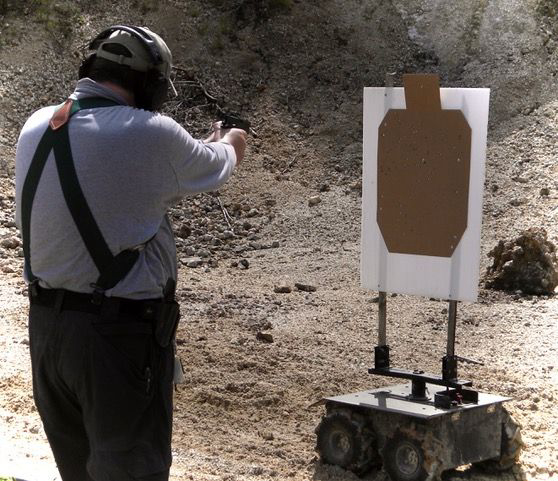
Most of our training and practice is with stationary targets. Yet fights are dynamic and fluid, with everyone moving. Preparing for the fight means learning how to engage moving targets.
There are two techniques for engaging moving targets – tracking and ambush. “Tracking” involves constantly keeping the sights on target, following its movement, and pressing smoothly on the trigger to fire accurate hits. The “ambush” technique requires moving ahead of the target, setting up a sight picture and waiting for the target to move into the sights, pressing the trigger at the appropriate time for the bullet to impact. Each technique has advantages and disadvantages.
For close range, tracking usually works best. It’s the most efficient way to get multiple, accurate hits on target in the shortest amount of time. The key is that you’ve got to constantly track the target with the sights before, during and after the shot. If you stop tracking while firing the shot and the target continues to move your accuracy suffers, just like when shooting clays or birds. You also have to track the target with eyes and pistol while reloading or clearing a malfunction. Otherwise, once the weapon is functioning again, you’re forced to play catch-up with the threat, or worse, visually lose the threat and now you’ve got no idea where they are and what they’re doing.
The ambush technique usually produces a little more accuracy and works well for longer distance shots. But it does consume more time. You pick up the target in your sights, then track past it, holding the sights on a point you anticipate the target will move into. At the appropriate time, according to distance and speed of the target’s movement you press off the shot. There’s also the possibility the target will change directions, never reaching the point you’ve set up for the ambush shot. The ambush technique also works well for repetitive motion, like when the threat keeps leaning out from around a corner.
The most important point the moving target makes is how truly important the fundamentals are. To hit a moving target, you have to apply the fundamentals of accuracy. This means using the sights, to the degree necessary, and getting a smooth press of the trigger without any anticipation of the recoil. To become a proficient shot means you can hit a moving target while moving. When you’re moving and engaging a moving target the fundamentals of marksmanship become even more important.
Practicing with moving targets really reinforces the importance of the fundamentals. Aim, hold, press and follow-through are mandatory for accurate hits. If you have difficulty with manipulations like reloading or clearing a stoppage on a stationary target it’s going to be really difficult to perform these actions while both you and the target are moving.
Although it may be difficult to find a way to practice with moving targets it’s something that needs to be done prior to the point that these skills are needed to save lives. Get creative, and put something together with ropes and pulleys that you can set up on the range. Attach some helium balloons to a motorized, remote-controlled toy. Or, get a group of shooters together to invest in one of the motorized systems specifically designed for live-fire range practice. The closer to “real” you can get – moving threats – the better prepared you’ll be for the fight.
Tiger McKee is director of Shootrite Firearms Academy. He is the author of The Book of Two Guns, AR-15 Skills and Drills, has a regular column in American Handgunner and makes some cool knives and custom revolvers. Visit Shootrite’s Facebook page for other details.